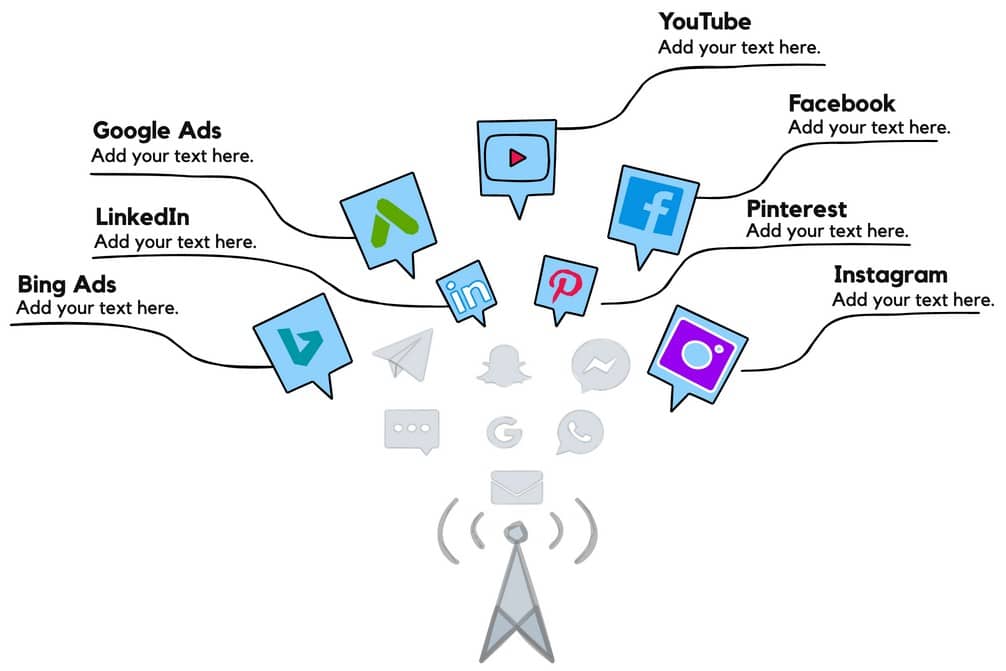The Ultimate Ophthalmic Marketing Guide
Chapter 8: Social Media

Chapter 8: SOCIAL MEDIA
This is as good a place as any to bring up the role social media plays in the 7R Strategy.
After “digital marketing,” “social media marketing” is the second most common way medical practices are taken for a ride when it comes to marketing spend.
The social media strategy typically proposed by one-stop-shopping marketing agencies is that, for a small monthly fee – say, a couple thousand dollars – your practice will see an increase in clicks, shares, and/or likes.
The problem with this promise is that it is extremely difficult to put a value on a click or a like unless it is part of a well- structured marketing funnel that takes the prospect through a specific journey from first impression to inquiry and ultimately to the purchase of a service or product. And, for the most part, these “visit, like, click, comment, and share” strategies just don’t do this. Instead, the clicks often just drive traffic to the homepage of the practice’s website, where, confused and befuddled, the prospect isn’t sure what they are supposed to do next. Since you have no clue who they are, or which ad/previous page drove them to your home page (or what service they are looking for), your social media spend has just gone into a marketing black hole.
Before you think we are totally dismissing social media marketing, be assured it absolutely has a place in scientific marketing. But rather than being talked into believing that social media is the be-all and end-all of prospecting, it is best to think of social media as just one of many channels available for your marketing operations.
Typical Social Media Promotion
Let’s compare and contrast typical social media promotions you might see a medical practice run with a direct response social media marketing funnel.
In Figure 16a, taken from an actual campaign, the practice runs a professional-looking ad with the headline “Is LASIK Right for You?” This headline speaks to anyone who has ever wondered whether they are a candidate for LASIK. But there is no compelling offer, either a giveaway or free information or a seminar or webinar. The call-to-action misses the mark here.

Figure 16a. A typical social media promotion for LASIK
The accompanying Facebook post reads “Ready to ditch your glasses? Discover if LASIK is right for you,” with a link to the practice’s website homepage (We’d have preferred to say, “Click here to discover if LASIK is right for you.” This specifically tells them what to do next). Not linking to a LASIK lead capture funnel that specifically greets Facebook visitors is the critical error in this campaign.
On the homepage, the prospect sees general information about LASIK and the practice’s LASIK services, which takes a couple of extra clicks, and that’s pretty much it. There are no specific instructions as to what their next step should be to find out whether they are a candidate, like a "Am I a LASIK candidate?" quiz or a "Download our LASIK patient guide here" link or click, text or call to speak to our refractive coordinator. In many cases, we find practices do not have a lead capture form on the page and they don’t use retargeting pixels.
Clicking the link takes them to the specific LASIK page (not the homepage), where the prospect sees general information about LASIK and the practice’s LASIK services, and that’s pretty much it. There are no specific instructions as to what their next step should be to find out whether they are a candidate. In many cases, we find practices do not have a lead capture form on the page and they don’t use retargeting pixels.
The web page analytics packages that are sometimes part of social media agency services might tell a practice how many people are viewing a page and what the source of the traffic is – Google, Facebook, the URL they visited from, etc. – but that does little to help determine which social media promotion campaign is most effective. Analytics don’t really help you reach those people who are on the fence, the undecideds who perhaps want questions answered before commit- ting to a formal evaluation (see “Nurturing and Addressing Objections” below).
In our next example (Figure 16b), we see what appears to be an offer – $999 per eye for bladeless LASIK – but without a call-to-action (or even a phone number!). The prospective patient is not sure what they are supposed to do. Does the $999 offer have terms or conditions? How would they know? Are they supposed to call or find further information online that could help?

Figure 16b
In the third example (Figure 16c), we see what seems to be a call-to-action, but is it really? How should they actually bring their world into focus? Is this an advertisement for LASIK? Or glasses? Or contacts? Maybe a bionic eye? Most likely this is part of a bigger campaign using brand awareness or corporate identity, perhaps from a larger practice or laser vision chain, and they have a big budget, so they can afford to show flashy image ads like this. You and I certainly shouldn’t be doing campaigns as unspecific as this. Without a real offer and a clear call-to-action, the prospective patient won’t know what step to take. Worse, it is next to impossible to determine the effectiveness of this ad.

Figure 16c
A New and Improved Social Media Promotion
Let’s take one of these and tweak it. The headline on Figure 16a is decent enough. We suggest this element should be split-tested– alternating between an “A” headline and a “B” headline, keeping the better-performing one, and then testing this against “C,” a third headline, and so on. The winner each time is called the control, and new headlines are pitted against it to see whether they convert better.
Sometimes an advertisement can be more effective with a pre- frame to the headline, such as “Are you tired of wearing glasses or contacts?” The idea is not to cast as wide a net as possible but rather to exclude as many unqualified people as possible. “Are you between the ages of 20 and 55?” This would exclude anyone who pos- sibly has cataract changes (they would go into a different funnel).
The Offer
Every direct response ad must have an offer (unlike branding ads). [Disclaimer: Please see the Legal & Compliance Considerations appendix so that you don’t run afoul of federal or state rules regarding inducement for surgery. In general, if offers contain something of nominal value or don’t require scheduling a surgi- cal procedure then you are probably safe, but always check with your legal counsel to be sure.]
An offer could be “Free informational Lunch and Learn next week” or “Complimentary sport sunglasses with every laser vision screening.” There might be a limited-time offer for a certain redemption period or a limited number of people, both examples of the concept of scarcity. Having a compelling offer makes it more likely the prospect will take action. Adding scar- city creates a sense of urgency.
The Call-to-Action
The call to action should spur the prospect to take action right away. This could be as risk free as clicking on a link to get more information or to download a report or to take an online quiz. It could be a more-difficult-to-persuade action of calling for an information packet or scheduling a free screening. It should be as specific as possible so that the prospect knows exactly what to do and what is going to happen once they do. Don’t take anything for granted.
Nurturing and Addressing Objections
You may not know it, but it often takes more than seven contacts with a prospect before they make a decision. Most salespeople stop at three. Some experts say this number has increased even further in this day and age of constant multimedia ad bombardment. But impressions alone are not useful unless we take the prospect by the hand and help them through their journey from initial interest to commitment.
For this reason, it is very helpful to know the major objections prospects have for each elective procedure.
With LASIK, for example, we know that potential patients have fears about the safety of the procedure and worry about the cost, so at the very least these issues should be addressed directly and preemptively.
Here are some ideas for nurturing wary prospects:
Implementing any (or all) of these ideas is certainly a big step up from doing none of them. However, without incorporating these elements into a system for tracking their utilization and following up with each prospect, you don’t truly have a scientific marketing funnel. And you might find yourself trying to explain to your partners where all of the marketing money has gone.
Key Takeaways
Share this guide on your social media account with the buttons below
Next: MARKETING TECHNOLOGY
